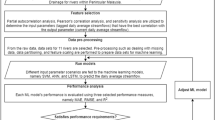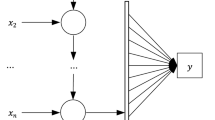Abstract
Accurate forecasting of salinity intrusion has a vital role in water resource management to mitigate and prevent its adverse effects. However, monitoring of salinity presents great challenges because the task requires a number of information, such as hydrological, geomorphological data. The objective of this paper is to compare the performances of different machine learning algorithms for saltwater intrusion prediction using a limited number of input data. To achieve this goal, we tested the performances of five algorithms (i.e., Simple Linear, K-Nearest Neighbors, Random Forest, Support Vector Machine and a deep learning algorithm Long Short Term Memory) for predicting saltwater intrusion in the Ham Luong River in the Vietnamese Mekong Delta using only salinity monitoring data. We used Nash−Sutcliffe efficiency coefficient, Mean Absolute Error, and Root Mean Square Error to evaluate the performances of the above mentioned five models. Our results showed that Long Short Term Memory was the most accurate and efficient model, which implies that deep learning algorithms might be more efficient than machine learning algorithms in case of limited input data. Besides, the study also showed that performance of the linear model was insignificant compared to the non-linear algorithms. The results also revealed that saltwater intrusion forecasts could be achieved even in the limited data context. The present study provided a precise and simple tool for early warning of saltwater intrusion in the Vietnamese Mekong Delta.





Similar content being viewed by others
REFERENCES
Alsharif, M.H., Younes, M.K., and Kim, J., Time series ARIMA model for prediction of daily and monthly average global solar radiation: The case study of Seoul, South Korea, Symmetry, 2019, vol. 11, p. 240.
Apel, H., Khiem, M., Quan, N.H., and Toan, T.Q., Brief communication: Seasonal prediction of salinity intrusion in the Mekong Delta, Nat. Hazards Earth Syst. Sci., 2020, vol. 20, pp. 1609−1616.
Becker, M.L., Luettich Jr, R.A., and Mallin, M.A., Hydrodynamic behavior of the Cape Fear River and estuarine system: A synthesis and observational investigation of discharge–salinity intrusion relationships, Estuar. Coast. Shelf Sci., 2010, vol. 88, pp. 407−418.
Choubin, B., Khalighi-Sigaroodi, S., Malekian, A., and Kişi, Ö., Multiple linear regression, multi-layer perceptron network and adaptive neuro-fuzzy inference system for forecasting precipitation based on large-scale climate signals, Hydrol. Sci. J., 2016, vol. 61, pp. 1001−1009.
Dang T.M. and De Smedt, F., A combined hydrological and hydraulic model for flood prediction in Vietnam applied to the Huong River basin as a test case study, Water, 2017, vol. 9, pp. 879.
Doan V.B., Kantoush, S.A., Saber, M., Mai, N.P., Maskey, S., Phong, D.T., and Sumi, T., Long-term alterations of flow regimes of the Mekong River and adaptation strategies for the Vietnamese Mekong Delta, J. Hydrol. Reg. Stud., 2020, vol. 32, pp. 100742.
Eslami, S., Hoekstra, P., Nguyen T.N., Ahmed K. S., Doan V.B., Do, D.D., Tran, Q.T., and Vegt, van der M., Tidal amplification and salt intrusion in the Mekong Delta driven by anthropogenic sediment starvation, Sci. Rep., 2019, vol. 9, pp. 18 746−18 755.
Frigge, M., Hoaglin, D.C., and Iglewicz, B., Some implementations of the boxplot, Am. Stat., 1989, vol. 43, pp. 50−54.
General Statistics Office (GSO), Statistical Handbook of Vietnam 2015, General Statistics Office of Viet Nam, 2015.
Hochreiter, S., The vanishing gradient problem during learning recurrent neural nets and problem solutions, Int. J. Uncertain. Fuzziness Knowledge-Based Syst., 1998, vol. 6, pp. 107−116.
https://scikit-learn.org/stable/
https://www.python.org/
https://www.tensorflow.org/guide/keras/rnn
Hunter, J.M., Maier, H.R., Gibbs, M.S., Foale, E.R., Grosvenor, N.A., Harders, N.P., and Kikuchi-Miller, T.C., Framework for develo** hybrid process-driven, artificial neural network and regression models for salinity prediction in river systems, Hydrol. Earth Syst. Sci., 2018, vol. 22, pp. 2987−3006.
Kornelsen, K. and Coulibaly, P., Comparison of interpolation, statistical, and data-driven methods for imputation of missing values in a distributed soil moisture dataset, J. Hydrol. Eng., 2014, vol. 19, pp. 26−43.
Khang, D.K., Kotera, A., Sakamoto, T., and Yokozawa, M., Sensitivity of salinity intrusion to sea level rise and river flow change in Vietnamese Mekong Delta impacts on availability of irrigation water for rice crop**, J. Agric. Meteorol., 2008, vol. 64, pp. 167–176.
Lago, J., De Ridder, F., and De Schutter, B., Forecasting spot electricity prices: Deep learning approaches and empirical comparison of traditional algorithms, Appl. Energy, 2015, vol. 221, pp. 386−405.
Lal, A. and Datta, B., Application of the group method of data handling and variable importance analysis for prediction and modelling of saltwater intrusion processes in coastal aquifers, Neural. Comput. Appl., 2020, vol. 33, pp. 4179−4190.
Liang, Z., Zou, R., Chen, X., Ren, T., Su, H., and Liu, Y., Simulate the forecast capacity of a complicated water quality model using the long short-term memory approach, J. Hydrol., 2020, vol. 581, pp. 124432.
Moriasi, D.N., Gitau, M.W., Pai, N., and Daggupati, P., Hydrologic and water quality models: Performance measures and evaluation criteria, Trans. ASABE, 2015, vol. 58, pp. 1763−1785.
Nash, J.E. and Sutcliffe, J.V., River flow forecasting through conceptual models, part I—a discussion of principles, J. Hydrol., 1970, vol. 10, pp. 282–290.
Nguyen, P.M., Kantoush, S., Sumi, T., Thang, T.D., Trung, L.V., and Binh, D.V., Assessing and adapting the impacts of dams’ operation and sea level rising on saltwater intrusion into the Vietnamese Mekong Delta, J. Jpn. Soc. Civ. Eng. Ser. B1, 2018, vol. 74, pp. 373−378.
Nguyen, X.H., Nguyen, K.D., and Trung, L.D., Assessing the adaptive capacity of farmers under the impact of saltwater intrusion in the Vietnamese Mekong Delta, J. Environ. Plan. Manag., 2019, vol. 62, pp. 1619−1635.
Palani, S., Liong, S.Y., and Tkalich, P., An ANN application for water quality forecasting, Mar. Pollut. Bull., 2008, vol. 56, pp. 1586−1597.
Passeri, D.L., Hagen, S.C., Medeiros, S.C., Bilskie, M.V., Alizad, K., and Wang, D., The dynamic effects of sea level rise on low-gradient coastal landscapes: A review, Earth’s Future, 2015, vol. 3, pp. 159−181.
Phan, T.T.H. and Nguyen, X.H., Combining statistical machine learning models with ARIMA for water level forecasting: The case of the Red river, Adv. Water Resour., 2020, vol. 142, pp. 103 656−103 692.
Qin, M., Li, Z., and Du, Z., Red tide time series forecasting by combining ARIMA and deep belief network, Knowl. Based Syst., 2017, vol. 125, pp. 39−52.
Rahman, M.H., Lund, T., and Bryceson, I., Salinity impacts on agro-biodiversity in three coastal, rural villages of Bangladesh, Ocean Coast. Manag., 2011, vol. 54, pp. 455–468.
Robertson, W.M. and Sharp, J.M., Estimates of recharge in two arid basin aquifers: a model of spatially variable net infiltration and its implications (Red Light Draw and Eagle Flats, Texas, USA), Hydrogeol. J., 2013, vol. 21, pp. 1853−1864.
Ross, A.C. and Stock, C.A., An assessment of the predictability of column minimum dissolved oxygen concentrations in Chesapeake Bay using a machine learning model, Estuar. Coast. Shelf Sci., 2019, vol. 221, pp. 53−65.
Schmidt, A., Mainwaring, D.B., and Maguire, D.A., Development of a tailored combination of machine learning approaches to model volumetric soil water content within a mesic forest in the Pacific Northwest, J. Hydrol., 2020, vol. 588, pp. 125044.
To, Q.T., Climate Change and Sea Level Rise in the Mekong Delta: Flood, Tidal Inundation, Salinity Intrusion, and Irrigation Adaptation Methods, in Coastal Disasters and Climate Change in Vietnam, Oxford: Elsevier, 2014, pp. 199–218.
Thoi, N.H. and Gupta, A.D., Assessment of water resources and salinity intrusion in the Mekong Delta, Water Int., 2001, vol. 26, pp. 86–95.
Tran A.D., Hoang, L.P., Bui, M.D., and Rutschmann, P., Simulating future flows and salinity intrusion using combined one- and two-dimensional hydrodynamic modelling-the case of Hau River, Vietnamese Mekong Delta, Water, 2018, vol. 10, pp. 897–917.
Tran, T.T., Ngo, Q.X., Ha, H.H., and Nguyen, N.P., Short-term forecasting of salinity intrusion in Ham Luong river, Ben Tre province using Simple Exponential Smoothing method, J. Viet. Env., 2019, vol. 11, pp. 43–50.
Uncles, R.J. and Stephens, J.A., The effects of wind, runoff and tides on salinity in a strongly tidal sub-estuary, Estuar. Coast., 2011, vol. 34, pp. 758–774.
Wolff, S., O’Donncha, F., and Chen, B., Statistical and machine learning ensemble modelling to forecast sea surface temperature, J. Mar. Syst., 2020, vol. 208, pp. 103347.
Zhang, J., Zhu, Y., Zhang, X., Ye, M., and Yang, J., Develo** a Long Short-Term Memory (LSTM) based model for predicting water table depth in agricultural areas, J. Hydrol., 2018, vol. 561, pp. 918–929.
Funding
This study was funded by the Thu Dau Mot University under grant number “DT.21.2-036.”
Author information
Authors and Affiliations
Corresponding author
Ethics declarations
The authors declare that they have no conflicts of interest.
Rights and permissions
About this article
Cite this article
Tran, T.T., Pham, N.H., Pham, Q.B. et al. Performances of Different Machine Learning Algorithms for Predicting Saltwater Intrusion in the Vietnamese Mekong Delta Using Limited Input Data: A Study from Ham Luong River. Water Resour 49, 391–401 (2022). https://doi.org/10.1134/S0097807822030198
Received:
Revised:
Accepted:
Published:
Issue Date:
DOI: https://doi.org/10.1134/S0097807822030198




